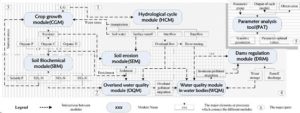HEQM: Integrated water system model and calibration

Integrated water system modeling is a reasonable approach to provide scientific understanding to tackle the severe water crisis faced all over the world and to promote the implementation of integrated river basin management.
After carefully evaluating the issues in the existing models, we proposed an integrated water system model by considering hydrological and biogeochemical processes, with the aim to simulate the spatial and temporal variations of several key elements (e.g. flow regimes, nonpoint source pools of nitrogen (N), phosphorus (P) and carbon (C), water quality variables in water body, crop yield) in complex basins.
The model takes full advantages of powerful interconnection and simulation functions of hydrological model at large spatial scale, elaboration of matter vertical movement in soil layers of ecological model at field scale and matter longitudinal movement in river networks of environmental model.
There are seven major modules and a parameter analysis tool, named as hydrological cycle module, soil biochemical module, crop growth module, soil erosion module, overland nutrient migration module and water quality module of water bodies, dam regulation module, as well as parameter analysis tool for model calibration. Multi-objective calibration is proposed to take account of observations in different processes at different spatio- and/or temporal scales.

Publications
Yongyong Zhang*, Quanxi Shao*, Aizhong Ye, Hongtao Xing, Jun Xia (2016). Integrated water system simulation by considering hydrological and biogeochemical processes: model development, with parameter sensitivity and autocalibration. Hydrology and Earth System Sciences 20(1): 529-553.
Yongyong Zhang, Quanxi Shao*. John Taylor (2016). A balanced calibration of water quantity and quality by multi-objective optimization for integrated water system model. Journal of Hydrology 538: 802-816.
Yongyong Zhang, Quanxi Shao, Shifeng Zhang, Xiaoyan Zhai, Dunxian She. Multi-metric calibration of hydrologic model to capture overall flow regimes. Journal of Hydrology (Accepted).
